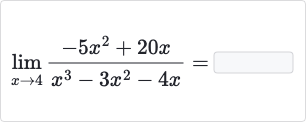AI tutor
Full solution
Q.
- Identify Function: Identify the function to which we need to find the limit.We are given the function and we need to find its limit as approaches .
- Substitute Value: Substitute the value of into the function to see if it results in an indeterminate form.Let's substitute into the function:(-5(4)^2 + 20(4)) / ((4)^3 - 3(4)^2 - 4(4))\(\newline= (-5(16) + 80) / (64 - 3(16) - 16)= (-80 + 80) / (64 - 48 - 16)= 0 / 0We get an indeterminate form \$0/0\), which means we need to simplify the function further to find the limit.
- Factor Numerator and Denominator: Factor the numerator and the denominator of the function.\(\newline\)We need to factor both the numerator and the denominator to see if there are common factors that can be canceled out.\(\newline\)Numerator: \(-5x^2 + 20x\) can be factored as \(-5x(x - 4)\)\(\newline\)Denominator: \(x^3 - 3x^2 - 4x\) can be factored as \(x(x^2 - 3x - 4)\)\(\newline\)Further factor the quadratic \(x^2 - 3x - 4\) as \((x - 4)(x + 1)\)\(\newline\)So the denominator becomes \(x(x - 4)(x + 1)\)
- Cancel Common Factors: Cancel out the common factors in the numerator and the denominator.\(\newline\)We have a common factor of \((x - 4)\) in both the numerator and the denominator.\(\newline\)After canceling out the common factor, the function simplifies to:\(\newline\)\(-5x / (x(x + 1))\)\(\newline\)\(= -5 / (x + 1)\)
- Substitute Simplified Function: Substitute the value of \(x\) into the simplified function to find the limit.\(\newline\)Now that we have simplified the function, let's substitute \(x = 4\) into the function:\(\newline\)\(-\frac{5}{(4 + 1)}\)\(\newline\)\(= -\frac{5}{5}\)\(\newline\)\(= -1\)
More problems from Negative Exponents
QuestionGet tutor help

